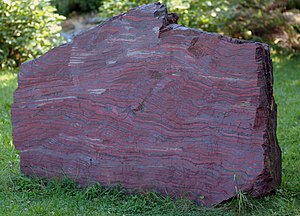Exceptionalism (geology)
Exceptionalism , also an actualism , is an interpretative principle or axiom for geological phenomena that were caused by extraordinary circumstances in the history of the earth and have no equivalent in the present. This makes exceptionalism the counter-principle to actualism .
According to the principle of actualism, the same geological processes and educational principles based on natural laws took place or worked in the past that can still be observed today on the surface and inside the earth . So the present is the key to understanding the past. Charles Lyell (1797–1875) and Karl Ernst Adolf von Hoff (1771–1837) were the most important representatives of this basic principle.
However, not all geological processes in the past can be explained by observations in the present. One example is from archaic known rock series bands iron ores ( engl . Banded Iron formation ). The eponymous alternation of iron oxides and chert could only arise at a time when the environmental conditions were different from today. The Precambrian atmosphere, and thus also the seawater in which this sedimentary rock was deposited, hardly contained any free oxygen . This allowed large amounts of water-soluble bivalent iron (Fe 2+ ) to accumulate in the sea. Due to the newly developed photosynthetic activity of autotrophic organisms ( Great Oxygenation Event ), however, large amounts of oxygen were released and the divalent iron was oxidized to insoluble trivalent iron (Fe 3+ ). The iron oxide precipitated out of the water and covered the bottom as sediment . The sediment then solidified in the process of rock formation ( diagenesis ) and formed the mighty band ore deposits . Today the earth's atmosphere contains about 21% free oxygen. As a result, water is usually saturated with oxygen, so that dissolved divalent iron is immediately oxidized to insoluble iron compounds at a neutral pH value (pH 7).
See also
Individual evidence
- ↑ Murawski, H., Meyer, W. (2004): Geological Dictionary. Spektrum Akademischer Verlag, 11th edition, 262 pp. ISBN 3-8274-1445-8
